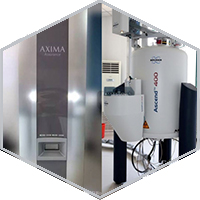Research Chemicals Peptides Synthesis

The amino group of one amino acid can condense with the carboxyl group of another amino acid to form a peptide, and the amide group formed is called a peptide bond in protein chemistry. Amino acids are the smallest molecules and proteins are the largest. Two or more amino acids are condensed to form several peptide bonds to form a peptide chain. Many peptide chains undergo multi-level folding to form a protein . Some proteins with small molecular weight are sometimes called "peptides". Dipeptide is a protein fragment composed of two amino acids only.
Peptides and Molecular Weight
Only those with molecular weights between 50 and 5,000 can be called peptides. Those with molecular weights between 5,000 and 10,000 are called large peptides/protein. Those with molecular weights between 50 and 2000 are called oligopeptides, and are also called small molecule active peptides. Biologists refer to peptides as "amino acid chains" and small molecule active peptides collectively as "bioactive peptides".
Common ones include Dipeptide, Tripeptide, and even Polypeptide, etc., while 2 to 10 amino acids are Oligo-peptide, and 10 to 50 amino acids are polypeptides. Usually those with less than ten peptides are more commercial applicability. Below 10-50 amino acids are used for medical R&D.
| Peptide Name | Type | Size(mg) | Inventory |
| Exenatide | R&D | 10/20/50 | In stock |
| Semaglutide | R&D | 10/20/50 | In stock |
| Octreotide | R&D | 10/20/50 | In stock |
| Salmon calcitonin | R&D | 10/20/50 | In stock |
| Liraglutide | R&D | 10/20/50 | In stock |
| RGD Peptide | R&D | 10/20 | In stock |
| PT-141 | Cosmetic | 10 | In stock |
| Tirzepatide | Research | 10/20 | In stock |
| Melanotan 2 | Cosmetic | 10/20 | In stock |
* Omizzur has 300+ peptide products in stock. Please contact our customer service for details.

Omizzur Quality Assurance
Omizzur's peptides are produced in strict accordance with the ISO quality management system. Each peptide is managed with a unique number. The crude product, purified collection solution and final lyophilized product are tested and analyzed by HPLC and LC/MS to ensure the accuracy of the product.
>> Click to Inquiry about research chemical peptides synthesis
FAQs: Basic Steps of Research Chemicals Peptide Synthesis
1. Introducing protective groups: Amino acid α-amino groups and side chain functional groups need to be protected to prevent unexpected chemical reactions during the reaction. Generally, protecting groups (such as Boc, Fmoc, etc.) are used to protect amino acids.
2. Activation: The protected amino acid needs to be activated to make it reactive so that the next amino acid can undergo a condensation reaction. The most commonly used activating reagents are DCC and HOBt.
3. Condensation: The activated amino acid condensates with the next protected amino acid to form a new peptide bond. The reaction conditions can also adopt aqueous solution phase or solid phase synthesis methods. In the generation of aqueous solution phase, the reaction is usually carried out in an organic solvent and an appropriate amount of alkali catalyst is added. In solid-phase production, amino acids are immobilized on a solid-phase support and the reaction proceeds in the solid phase.
4. Repeated condensation: According to the length of the required peptide sequence, the condensation reaction is repeated to gradually expand the length of the peptide chain.
5. Remove the protecting group: After completing the peptide synthesis, the protecting group must be removed and the normal amino acid free functional groups restored.
6. Purification and analysis: The generated peptide must be purified, and chromatographic (such as RP-HPLC) are generally used to separate and purify the peptide. After separation and purification,MS, NMR and other methods can be used to analyze and confirm the structure type.
How to Store Synthetic Peptides?
Generally, peptides need to be protected from light for long-term storage and should be stored at -20°C. They can be stored at 4°C for short-term storage. It can be shipped at room temperature for short periods of time.
Peptides are stable at -20°C, especially if freeze-dried and stored in a fridge. Freeze-dried peptides can be brought to room temperature before exposing them to air. This will reduce the effects of humidity and when freeze drying is not possible the best approach is to store in small working sample sizes.
For peptides containing Cys, Met or TrP, deoxygenated buffers are essential for their dissolution, because this peptide can be easily oxidized by air. Slowly flowing nitrogen or argon gas over the peptide before sealing the bottle will also reduce the oxidation. Gln- or Asn-containing peptides are also susceptible to degradation, and all of these peptides have a limited lifetime compared to those without these peptides.
If the purity of my peptide is 95%, then what is the remaining 5%?
Peptide purity is usually determined by HPLC using a standard acetonitrile gradient of 1% per minute. During the synthesis process, the cross-linking efficiency between amino acids does not always reach 100%, thus producing a series of impurities with missing amino acids.
Most of these amino acid-deficient impurities are removed during the purification process, but a few impurities have chromatographic behavior very similar to that of the target peptide. These amino acid-deficient impurity peptides remain in the peptide sample and constitute the remaining few percent.
Application of Peptides in Research Fields
Peptides are generally divided into: peptide drugs and health products. Traditional peptide drugs are mainly peptide hormones. The development of peptide drugs has developed into various fields of disease prevention and treatment, especially in the following fields.
1.Anti-tumor peptides
The occurrence of tumors is the result of a variety of factors, but ultimately involves the regulation of oncogene expression. In 2013, many tumor-related genes and regulatory factors that exert effects on tumors have been discovered.
Screening for peptides that specifically bind to these genes and regulatory factors has become a new focus in the search for anti-cancer drugs.
2.Antiviral peptides
The virus binds to specific receptors on host cells and adsorbs cells, relying on its own specific proteases for protein processing and nucleic acid replication. Therefore, peptides that bind to host cell receptors that can bind to active sites such as viral proteases can be screened from the peptide library for antiviral treatment.
In 2013, Canada, Italy and other countries have screened out many small peptides with antiviral properties from peptide libraries. Some small peptides have entered the clinical trial stage.
3.Cytokine mimetic peptide
Using known cytokine receptors to screen cytokine mimetic peptides from peptide libraries has become a research hotspot around the world in 2011. Mimic peptides of various growth factors such as human erythropoietin, human thrombopoietin, human growth hormone, human nerve growth factor and interleukin-1 have been screened.
The amino acid sequences of these mimetic peptides are different from those of the corresponding cytokines, but they have the activity of cytokines and have the advantages of small relative molecular weight. These cytokine mimetic peptides are in the clinical research phase.
4.Antibacterial active peptides
When insects are stimulated by the external environment, they will produce a large number of cationic peptides with antibacterial activity. In 2013, more than a hundred antibacterial peptides were screened out. In vivo and in vitro experiments have confirmed that many antimicrobial peptides not only have strong antibacterial and bactericidal abilities, but also can kill tumor cells.
5.Peptide vaccine
Peptide vaccines and nucleic acid vaccines were one of the research areas that received more attention in the field of vaccine research in 2013. In 2013, a large amount of research and development was carried out on viral peptide vaccines in the world. For example, in 1999, the US NIH announced the results of clinical trials of two HIV-I virus peptide vaccines on humans.
Researchers have screened a peptide from the outer membrane protein E2 of hepatitis C virus (HCV), which can stimulate the body to produce protective antibodies. Malaria multivalent antigen peptide vaccines are being developed in the United States. The cervical cancer human papillomavirus peptide vaccine has entered Phase II clinical trials.
6.Diagnostic peptides
The main use of peptides in diagnostic reagents is as antigens to detect antibodies against corresponding pathogenic organisms. The characteristics of peptide antigens are that they are more specific than natural microbial or parasite protein antigens and are easy to prepare.
Most of the peptide antigens used are obtained from the analysis and screening of natural proteins of the corresponding pathogens, and some are brand-new peptides obtained from the screening of peptide libraries.
Customer Service Center
 Research Chemical Peptides Order:
Research Chemical Peptides Order:
2. Mail us now: [email protected]
* Please mail us your product name and quantity needed, Omizzur customer services will get in touch with you within 1 hour.
Copyright © 2020 Omizzur Inc | Terms & Conditions | Privacy Notice | Sitemap